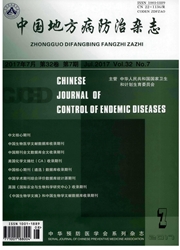

 中文摘要:
中文摘要:
目的调查慢性饮水型砷中毒病区砷中毒人群发、尿、血砷含量并进行皮肤病理学检查。方法采用高效液相色谱法测定水砷含量;采用超低温捕获-还原气化-原子吸收分光光度法测定发、尿、血砷含量;皮肤样本进行HE病理学检查。结果砷中毒患者饮用水中三价无机砷(AsⅢ)、五价无机砷(AsV)、有机砷及总砷(tAs)水平均显著高于无砷暴露对照人群;砷中毒患者毛发中无机砷(iAs)、二甲基砷(DMA)及tAs水平,尿中iAs、甲基砷(MA)、DMA及tAs水平,血液中MA及DMA水平均显著高于相应无砷暴露对照人群。发砷、尿砷及血砷水平男女问无显著差异。皮肤HE病理切片中黑色素细胞出现凋亡并有黑色素产生增多现象。结论砷性皮肤损伤可能与血液中高水平的MA关系密切;砷性皮肤色素脱失可能与黑色素细胞发生凋亡有关。
 英文摘要:
英文摘要:
Objective To investigate the level of arsenicals in the hair, urine and blood of patients exposed to arsenic through drinking water and the characteristics of melanocyte lesions. Methods Levels of arsenicals in water were measured by HPLC ; Arsenicals in hair, urine and blood were measured by HPLC - HG -AAS. Pathological examinations were done by HE stain. Results Levels of Aslll, AsV, organic arsenicals and tAs in water consumed by patients were significantly higher than those of control. Levels of iAs, DMA, and tAs in hair, iAs, MA, DMA and tAs in urine, MA and DMA in blood of patients were significantly higher than those of non - exposure persons. No significant differences were found between male and female about the arsenical levels in hair, urine and blood. Increased melanin production and apoptosis of melanocyte were found in the pathological samples. Conclusions Arsenic - related skin lesions may have some relationship with high level of MA in blood. Depigmentation induced by arsenic exposure may be resulted by apoptosis of melanocytes.
 同期刊论文项目
同期刊论文项目
 同项目期刊论文
同项目期刊论文
 期刊信息
期刊信息
